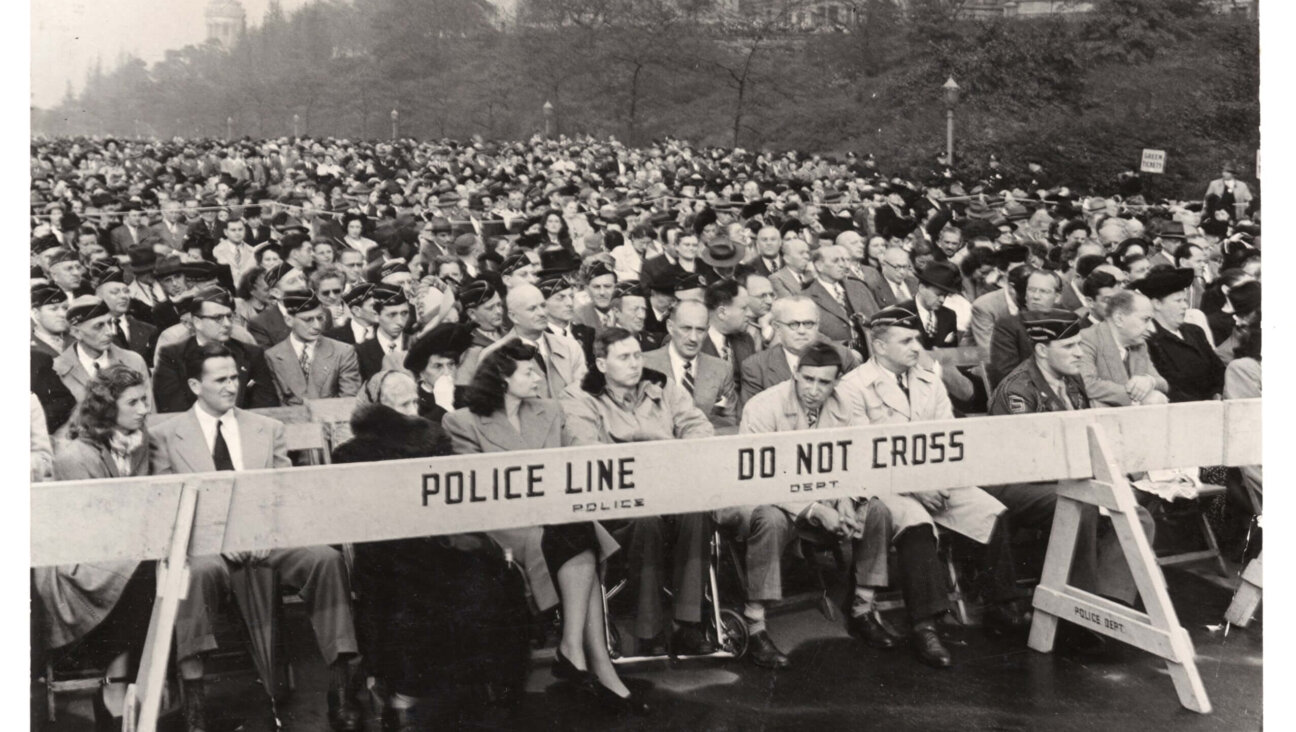Is ‘Amy Winehouse’ Exhibit Too Loving a Portrait?

Image by Mark Okoh
(Haaretz) — “Amy Winehouse: A Family Portrait,” an exhibition originally curated with the assistance of the late singer’s brother and sister-in-law at the Jewish Museum London, has relocated, almost intact, to Tel Aviv.
In addition to the fact that Winehouse, who died from alcohol poisoning at age 27 in 2011, has won pride of place in terms of London’s Jewish cultural heritage, she was also a superstar who scooped up five Grammy Awards on a single night. Posthumously, her “Back to Black” album became the 21st-century’s bestselling album in Britain, at least for a time.
In anticipation of exceptional interest in the exhibit here, too, Beit Hatfutsot has also arranged for extended hours for the show, which is on through May 1 of next year.
It has created a real media buzz, and even on a recent weekday morning, the large gallery space was bustling with visitors. On my way out, I was trampled by a group of ninth-graders, eager to make their way inside.
A fairly large sign at the entrance publicizes names of some 10 sponsors of the exhibition, some of them commercial entities. One could be cruel and point out the irony in the fact that one of them is the popular Guinness beer brand, considering the circumstances of Winehouse’s death. Prominently mentioned at the show is also the fact after the singer’s death, her family established a foundation dedicated to raising awareness of the dangers of alcohol and drug abuse among young people.
If anyone had preconceived notions about Beit Hatfutsoth as a stogy, irrelevant institution, the Winehouse show offers a good opportunity to say that in recent years, the museum’s exhibitions have reflected genuine contemporary awareness. Indeed, the major current exhibition at the museum, “Mazal U’Bracha” (“Good Fortune and a Blessing”), also gives the impression of being a show with its finger on the pulse.
Along with my praise for Beit Hatfutsoth for its willingness to host a British “invader” of the highest order, featuring the most trivial details of pop culture and completely lacking any national-official aura – I might be perceived as the responsible adult when it comes to this particular exhibition, taking issue with it not being sufficiently “official” or detached.
The bottom line is that this is a shrine to Winehouse, of the kind that mainly recalls homemade shrines created by Elvis Presley fans that you might come upon in remote places in the American heartland. It is apparent that the people at Beit Hatfutsoth felt a bit uncomfortable mounting an exhibition in which the major displays are clothing that Amy wore, her guitar, records from her private collection, a Camden Town station Tube ticket she used on May 5, 2000, and – I kid you not – half a display case of her refrigerator magnets.
There is some reference to the musical talent on her father’s side of the family, including a quote from the singer herself when she was 13. At the time, she said that unlike her father, she wanted to do something with her talent and not just sing in the office as he did.
But no historical context about the interesting if not unusual story of her family, reflected in the displays, can downplay the fact that this is a consecrated site commemorating Winehouse’s life. That’s pretty cool, but one does expect a respected museum to provide a broader context.
The seeming discomfort of the staff also finds expression in the fact that, indeed, an introductory accompanying exhibit has also been created by them, entitled “From the East End to Golders Green”: It is drawn from the museum’s permanent collection to provide a bit of background on the story of British Jewry between the end of the 19th century and the beginning of the 20th. It offers a sort of balance to the Amy Winehouse displays, providing fitting background on the atmosphere of the earlier period without overwhelming the visitor with details. There is a representative and moving selection of photos, several surprising quotes, information on the hardships of the East End in 1904, and a video clip of the period.

Image by charles moriarty
This exhibit meshes beautifully with Winehouse’s family tree, the descriptions of the singer’s fantastic grandmother, and the depiction of the singer’s London and of her family over the years; there is also reference to the fact that her father drove a black English taxi. Also on show are great childhood pictures from the 1980s, reflecting the stereotypical geeky awkwardness of Jewish life in England. This doesn’t have to be stated explicitly, because the melodrama of the routine background from which an over-the-top, enduring gem like Winehouse came finds expression between the lines.
There are some amazing biting, witty quotes from Winehouse’s youth on the walls of the gallery, in the star’s own handwriting. They may be kitschy or emotionally manipulative, but again, this is a shrine to a pop idol. This is the aesthetic language and emotional tone of such a site, and turning your nose up at it simply shows a lack of understanding of the fact that this is not an exhibit that is removed or reserved when it comes to its subject, for even a moment.
What the hell. There is a special display featuring a suitcase of scattered family pictures, which the accompanying text explains that Winehouse opened with her father a few days before her death. I pressed my face right up to the display window to see Amy’s guitar from as close as possible. It’s full of her fingerprints. Amy actually touched it. You feel chillingly close to her. It’s almost as if she is there.
Where I really begin to tear up, of course, was next to the case displaying devoted her record collection – from the Mickey Mouse Club recording of her childhood to the inevitable Frank Sinatra and Marilyn Monroe, Thelonious Monk, Ray Charles and Stevie Wonder.
What really got me was a Sarah Vaughn album. I don’t actually like most of that music, but this album was purchased at the immortal second-hand Music Exchange record store in Notting Hill. It still had the sticker on it that the store used on albums whose prices were lowered by a pound sterling every month the recording remained unsold. (It cost Winehouse 3 pounds). Standing there in front of the album, I imagined the singer picking it up, flipping through the store’s merchandise as I myself did innumerable times.
I had the sense that I almost knew her as I recalled her amazing voice, which visitors to the exhibition hear only at the end. (Instead, the soundtrack of the exhibit features a playlist of Winehouse’s own favorite songs, which she herself prepared.) It was when I once again recalled that she is no longer with us that tears welled up in my eyes.
For his part, Alex Winehouse, the singer’s brother, wrote that the exhibition is not a shrine or memorial to his sister. Amy may have been the most famous member of his family, he explained, but as the visitor will see, she was not at the center of the family. No one was. And the exhibit is also not an attempt to portray who his sister was, he wrote, but rather to paint a portrait of a young woman who was first of all a little Jewish girl from North London who had a lot of talent.
I don’t think that the fact that the exhibition is actually a shrine conflicts at all with Alex’s nice comments, nor does it show that he was mistaken. Maybe he was, but that is something that could be expected when one considers the celebrity culture. And in this context, the show succeeds in its ability to maintain a feeling of intimacy, of family, that is not diminished despite all the fetishism over the things that Amy touched.
It is also worth noting another success with respect to avoiding the biggest trap that one might have expected from such an exhibition: There is no reference at all to Winehouse’s death, either visual or textual. Nor is there mention of the self-destructive behavior that led to it; the heartbreaking, embarrassing performances that she gave in a catatonic state; or the relationships that were destroyed along the way.
The exhibition may arouse reflexive left-wing criticism over censorship, over fudging of reality and being in denial, over the contradiction between the Winehouse Foundation’s pretensions of raising awareness of the problems that killed Amy and their total absence in the exhibition. And there are other lapses, for example: the lack of any attention to Winehouse’s transition from anonymity to stardom.
On second thought, however, I would justify the absence of anything attesting to Winehouse’s destructive behavior and pitiful state. The exhibition maintains its loving, intimate, restrained, family-oriented tone. The work of the Winehouse Foundation is being carried out, I imagine, among young people who really need its help. There is an interest here in respecting the departed and in an entirely justified avoidance of the voyeuristic snuff film culture, with its depictions of death. Indeed, there is no reason for such things to be shown at an exhibition mounted by the family. It’s also understandable that along the way, it makes it easy for Beit Hatfutsot to draw record numbers of visitors with a display that is suitable for the entire family.
For more stories, go to Haaretz.com or to subscribe to Haaretz, click here and use the following promotional code for Forward readers: FWD13.

I hope you appreciated this article. Before you go, I’d like to ask you to please support the Forward’s award-winning journalism this Passover.
In this age of misinformation, our work is needed like never before. We report on the news that matters most to American Jews, driven by truth, not ideology.
At a time when newsrooms are closing or cutting back, the Forward has removed its paywall. That means for the first time in our 126-year history, Forward journalism is free to everyone, everywhere. With an ongoing war, rising antisemitism, and a flood of disinformation that may affect the upcoming election, we believe that free and open access to Jewish journalism is imperative.
Readers like you make it all possible. Right now, we’re in the middle of our Passover Pledge Drive and we need 500 people to step up and make a gift to sustain our trustworthy, independent journalism.
Make a gift of any size and become a Forward member today. You’ll support our mission to tell the American Jewish story fully and fairly.
— Rachel Fishman Feddersen, Publisher and CEO
Join our mission to tell the Jewish story fully and fairly.
Our Goal: 500 gifts during our Passover Pledge Drive!























